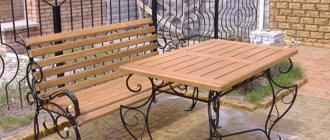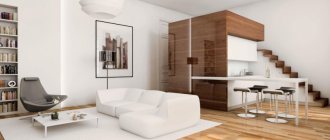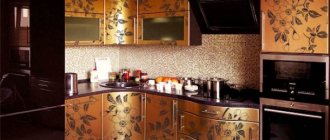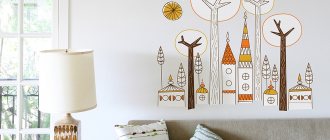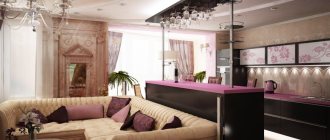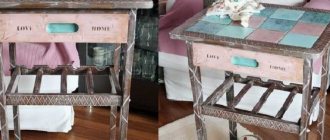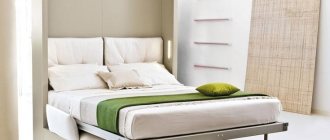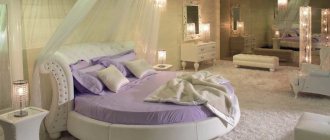To create a unique design in large apartments and private houses, the premises are often decorated with metal furniture. Forged products add elegance, sophistication, aristocracy, and comfort to the overall decoration. Forging of interior products is carried out using ancient technologies that were previously used by blacksmiths and industrial enterprises.
Decorative elements in the interior
Types of forging
The technological process of forging is divided into separate types depending on different criteria. Depending on the mechanization of labor:
- Stamped forging. A technological operation carried out by large enterprises. Performed using industrial equipment.
- Free, handmade, artistic. Performed with hand tools or simple machines. Finished products are not considered mass produced; they are made to order.
Depending on the metal processing method:
- Cold - metal rods, strips, sheets are processed using manual machines and power tools.
- Hot - before processing, the workpieces are heated. The metal becomes more pliable.
The hot forging process must be approached responsibly. It is recommended to study specialized literature in advance and communicate with experienced blacksmiths. When working with different metals, you need to take into account the characteristics of each material.
Manufacturing of forged products (Photo: Instagram / kovka_ust_labinsk)
In what style should you use forged decor?
Recently, handicrafts and ancient crafts have become increasingly popular. Therefore, forged decor has undoubtedly been a trend for several years now. It is suitable for absolutely any interior. To make it look harmonious, you need to take into account some nuances and make sure that the decor matches well with the rest of the items in the room.
Forged metal decor is good because it is universal: it is suitable for a classic interior and for the avant-garde. Let's list some stylistic features:
1.Russian-Byzantine style - it is characterized by complex interweaving of geometric shapes, lines and plant motifs. This style symbolizes Russian spirituality and the elegance of aristocracy.
2. Baroque - the style stands out for its luxury and majesty. Its decor combines curls of the most unusual shapes with garlands.
3. Rococo is a refined and extraordinary style derived from Baroque. Rococo absorbed all its advantages. Only here you can encounter special grace and filigree.
4. Provence - decorative elements with soft lines of plant motifs are suitable for it. The mood of Provencal style is emphasized by patterned legs and backs of furniture, stair railings and armrests.
5. Loft - this style is characterized by straight geometric lines. The interior is emphasized by partitions, screens, and tables on forged legs in a minimalist style.
One of the fashionable techniques is the play of contrasts - this can easily be implemented in a room of light colors by introducing dark-colored forged decorative items into it.
A few forged items are enough to set the tone for your home. These could be coffee table legs or even patterned frames for your family photos.
Remember that forged decor in the interior is “speaking”, so the background should be calm and laconic.
Forged products can decorate not only the interior of rooms, but also the exterior of a country house.
Related article: [It will be clean] How to clean a bathtub from plaque and rust?
Forged metal can be used for:
- swing;
- garden tables and chairs;
- benches and barbecues;
- street lamps, forged cornices.
This list can be enumerated endlessly.
The same set of furniture with forged elements can be updated as needed, changing textile covers, pillows of different textures, styles, and colors. This way you can change your surroundings with little spending.
In any case, forged parts will be the highlight of your interior.
The best posts
- Creating an interior: how to choose furniture to match the wallpaper?
- Wallpaper backing and its use
- Superhero Apartment: Tony Stark [Iron Man] Home Review
- Drawings for Wood Carving - more than 100 sketches
- Knitting patterns for women's pullover: how to knit raglan with description and photo
- Wallpaper with flowers: photos in the interior, flowers on the wall, large poppies, roses, small bouquets, white peonies, 3D red and pink, watercolor, video
- DIY shoe stand
- Learning to mix dry putty
Selection of forged products to suit the interior style
Products for different styles:
- Provence. It is better to decorate walls and furniture with floral designs and individual metal branches.
- Scandinavian style. The geometry should not have smooth corners or smooth bends. All decorative elements must be strict, consisting of straight lines connected at sharp angles.
- Rococo. The lines should be refined, gradually moving towards massive objects.
- East style. Includes ornate intertwining lines, leaves, branches. There should be no sharp corners or a large number of straight lines.
- Loft. Sharpness should prevail in the design. It is necessary to make more sharp corners, objects, and rough-shaped decorations.
Attention should also be paid to the color scheme. For example, for the Scandinavian style and loft, dark shades and natural metallic colors are suitable.
Rococo style design (Photo: Instagram / n_hramcova)
Forging in the interior of the hallway
Forged furniture is the most rational solution for such an issue as the interior of a hallway. Such furniture has a combination of the following characteristics: convenience, aesthetics, reliability, quality, durability, elegance, luxury. A set of furniture for a hallway, consisting of forged products, has an important advantage - an optimal range of items suitable for any spatial features of the hallway. It may consist, for example, of: a shoe rack, including a seat and a shoe rack, a floor or wall hanger, lamps, a large mirror in a metal frame, a small table, a flower stand, a stool and any other furniture component you need. All these items can be matched to the style already existing in the living space. They can be combined with wood or glass, and painted in a wide variety of colors.
Where can forged products be used?
Forging and design are compatible concepts. With the help of forged products you can decorate a room, the facade of a building, a private area, or make a massive fence. Forged items perform a decorative and practical function.
Products for interior decoration (Photo: Instagram / superkovka.by)
Outside the building
For private homes and gardens you can make:
- bars on windows, doors;
- railings for stairs on the porch;
- terrace fencing;
- barbecues, garden furniture;
- fencing - sections of fences, wickets, gates;
- lanterns, decorative figures;
- flower beds, canopies.
Forged items that will be located outdoors must be made of alloys with alloying additives that increase anti-corrosion properties, or have a protective coating against rust.
Forged lantern (Photo: Instagram / metallokovka)
Furniture cladding
Forged products are suitable for cladding furniture. Metal objects attract attention. Furniture made from other materials remains a common background. For sale you can find forged:
- tables;
- chairs;
- stands;
- shelves;
- cabinets;
- beds;
- benches;
- mirrors
Forged elements must be supplemented with different materials - plastic, wood, glass.
Forged table and chairs (Photo: Instagram / blacksmith_moscow_kovka)
Functional items
Kinds:
- sconces, chandeliers;
- stair railings for stairs inside or outside the house;
- partitions, screens;
- stands, hangers;
- frames for mirrors or pictures;
- door fittings;
- bars on windows;
- door panels;
- flower beds, fireplace grates.
Decorative inserts
Such elements include decorative elements for interior and exterior decoration of the house - branches, candlesticks, vases, wall panels.
Forged vases (Photo: Instagram / nikitademm)
The use of forged products in the kitchen interior
Forging can be a non-trivial and practical solution to the interior design of your kitchen. The functionality and aesthetics of her products can transform any kitchen space into a dining area showcase. The advantages of metal products are their practicality, durability, and compatibility with many other materials, such as wood or glass. A large selection of kitchen forged items allows you to choose what suits you, what you need or what you like best. For example, this could be an armchair or stool, high chairs or banquette sofas, a bottle holder or flower stand, a bar set or decorative hangers, oval or round tables.
As you have seen, metal products can be used both in the exterior and in the interior, both for beauty and for practical use, for example, forged railings. At the same time, they not only do not violate the integrity of the existing style, but on the contrary, they emphasize it, adding novelty.
DIY making
Exclusive forged jewelry can be ordered from a blacksmith's workshop, but it is expensive. To save money, you can try to make a decorative element from metal yourself. To do this, you need to choose a forging technology (hot or cold). The list of consumables, tools, and equipment will depend on your choice.
Preparing and drawing up a diagram
Before you start making a decorative product, you need to draw up a diagram. To do this, you need to draw individual details of the future product on a sheet of paper and cut them out along the contour. Next, you need to transfer the dimensions to metal blanks and cut them with a grinder.
Tools and materials
Forging tools are selected depending on the metal processing method. For hot forging:
- bending forks;
- sledgehammers, hammers of different weights;
- blacksmith's tongs;
- metalsmith's and blacksmith's chisels;
- steel undercuts;
- rolling, nailing;
- grinder, welding machine;
- metal brush, set of files;
- ironers, crimpers.
You will also need a forge. You can make it yourself from fireclay bricks. If the forge is in a private workshop, make it open and heat it with coke coal.
Tools, equipment for cold forging:
- Vices of different sizes.
- Welding machine.
- Grinder with discs.
- Drill with drills for metal.
- Gnutik is a manual machine for bending metal blanks at different angles.
- Volumetric - a device for creating three-dimensional images on metal surfaces.
- A twister is a device that can be used to twist several metal rods into one piece.
- A snail is a hand-held machine used to create spirals and twisted products.
- Wave is a device for creating patterns from metal strips and rods.
- Hydraulic Press.
To make decorative elements you will need fittings of different diameters, metal sheets, and strips.
Sledgehammer (Photo: Instagram / master_expert)
Manufacturing
Cold forging is a simple way to make decorative items. The method includes several stages:
- Preparing metal blanks, cutting them to the required sizes using a grinder.
- Giving parts the required shape using manual machines.
- Connecting individual metal elements to obtain a finished product. A welding machine is used for this.
The last stage of manufacturing an item using cold forging is cleaning the welds and coating the joints with an anti-corrosion compound.
Hot Forging Process:
- Creating a sketch, preparing metal blanks for heat treatment.
- Heating of workpieces to a certain temperature.
- Giving the workpiece the required shape.
- Creating bends.
If you don’t have a pyrometer, you can determine the heating temperature of the metal visually by monitoring changes in the shade of the surfaces.
Forged interior items
Metallic lace is appropriate in any room - from the smallest to the most luxurious. Forged furniture is found everywhere in the interior. In the bedroom there is a bed with an openwork headboard, in the living room there is a table and chairs with ornate legs, in the hallway there are original hangers and benches. Forging in the interior is used in various interesting elements - partitions, railings, chandeliers, candelabra and grilles. Openwork metal in combination with glass creates airiness, and with wood - good quality. These unusually beautiful products do not lose their attractiveness even after prolonged use.
Forged partitions in the interior
Spacious layouts combining several rooms are now popular. The openwork partitions with forging in the interior of the apartment look fabulous, serving to zone the space. They do not look bulky, but look light; they are a decorative canvas with curls, floral themes, and leaves. Decorative forging in the interior can be decorated with bright stained glass inserts, forged roses, lilies, leaves, flowers, and decorated with fresh climbing flowers. For special rooms, the grilles can be decorated with bronze or aged.
Forged stairs in the interior
Metal railings for steps are a design element. Forged stairs in the interior of a house are made in any stylistic direction - from rich baroque to restrained minimalism. Railings with a minimum number of patterns are used - clamps, rings, twisted rods or a rich pattern with floral motifs, leaves, curls. Forging in the interior is decorated with gilding, brass elements, precious stones, crystal and glass. Often the railings are complemented by wooden handrails, posts, and carved balusters.
Forged bed in the interior
Furniture with openwork metal elements becomes the highlight of the design. A wrought-iron bed in a bedroom interior with lace headboards and legs looks elegant and creates a palace atmosphere. Ornate patterns on the headboards and gilded areas turn the room into royal chambers. Grilles come in both bent rods for a floral, modernist theme, and in strict lines for a minimalist design.
Snow-white wrought-iron beds look especially elegant; metal lace in this color will help create a romantic Parisian design or a more classic one with wooden elements. Rustic or country style involves the use of simpler patterns. Beds with iron vertical posts under the ceiling look more massive; they can be decorated with a canopy. Metal intricacies look good with a forged table, a mirror rim, or an elegant soft banquette. Iron products are strong and durable.
Wrought iron chairs in the interior
Unusual furniture brings charm to the room. Forging in the interior of the house is used to make a beautiful soft group. Armchairs made by artistic metal processing can be both ascetic and majestic. They have graceful legs, curved smooth armrests, removable or stationary soft pillows. There are exclusive options - rocking chairs, models stylized as a carriage or a retro car. Wrought iron chairs look harmonious with banquettes and coffee tables decorated with similar patterns.
Forged cornices in the interior
Metal structures are used to decorate windows. Decorative forged products for the interior in the form of cornices emphasize the beauty of curtains; massive brackets are made of openwork metal. Tips are the main part of a decorative product. They are made in the form of geometric patterns, flower buds, intersecting lines, and spiral patterns. It is appropriate to repeat forging in other design elements - door and furniture handles. Often, products are artificially aged, plated with gold, and inlaid with rhinestones or stones.
Forged clock in the interior
Metal in the setting plays an important decorative role. A clock with a lace frame is an original forged product for home interior. There are wall-mounted options of any size - huge antique models with Roman numerals, sun-shaped clocks, a classic dial surrounded by forged curls. Gold-colored metal with imitation lilies turns the product into a royal masterpiece. The watch, mounted on an elegant forged retro bracket, looks original. Table walkers on openwork metal legs look beautiful in the living room or office.
Forged mirror in the interior
Metal is used to frame objects and give them an elegant look. Forged products in the interior of the house will help to stylize the room according to the chosen era. A mirror with an orthogonal pattern emphasizes the ancient Roman design, a complex floral pattern suits Art Nouveau, a massive openwork frame with gilding will decorate a room decorated in a Baroque style.
Roses and orchids with leaves can “bloom” on the frame, grapes and hops can curl, cranes or exotic birds can be located. The wall-mounted model is often complemented by a shelf made of wood or glass. The full-length floor mirror with iron legs looks gorgeous. Artistic processing turns any product into a work of art.
The forging in the interior captivates the eye - the smooth lines of the metal combine strength and grace. A fireplace grate, a chandelier, a candlestick, a bed—the products bring stability and beauty to the home, attracting attention with their rich relief, ornateness and massiveness. Metal lace fits into all style trends - from classic to modern, and goes well with wood and glass. It gives the room medieval grandeur and at the same time looks airy and light.
Product care
There are no special rules for caring for forged products. It is enough to regularly clean metal surfaces from dirt with a dry or damp cloth. For products located outside, it is recommended to renew the anti-corrosion coating every month, for items located inside the house - every 3 months.
Forged elements are suitable for decorating different interior styles. They are made to order by blacksmith shops and large metalworking enterprises. If you want to save money, you can forge a decorative element yourself. To do this, you need to study forging technology (hot or cold), learn how to work with different types of metals.
Forged products for a country house
If we consider where forged products are used most, then the answer to this question will be obvious - in country houses.
Safety is the most important thing. In country houses, bars are often installed on the windows to protect the premises from illegal entry. The options for making gratings are as varied as a person’s imagination allows.
Making banal straight rods just for protection is not interesting. This element must also carry an aesthetic load. You can create original metal patterns that will not only secure your country house, but also give it an interesting appearance.
Why not show everyone the special features of the house as soon as they enter? There are many options for implementing such an idea. You can use a wrought iron mailbox with metal legs. This product will make your home stand out from others.
Upon entering the courtyard, visitors can be greeted by beautiful flowers planted in outdoor wrought iron stands. And in the room itself, the guest will see a decorative lamp.
Implementing the ideas described above is quite simple. Besides, it's not that expensive. For example, cold forging of a chandelier will cost much less than hot forging.
Living room design
An excellent addition to the interior in the living room are a wrought iron fireplace grate and other fireplace items. A special atmosphere of extravagance is created by the presence of small forged trinkets in the room. Curved legs of coffee tables and chairs look especially elegant. You can combine furniture in the living room with:
- flower stands;
- shelves for souvenirs;
- floor vases;
- chandelier.
Important. In order for forged items to look harmonious, they need to be selected so that the sophisticated lace matches the design style of the home. If the design of the house is decorated in a classic style, symmetrical simple patterns prevail in it. The romantic style is characterized by curls and various flowers.
Baroque is decorated with fancy asymmetrical patterns. The Renaissance is dominated by depictions of fruits and fruits, especially vines. Modern high-tech is interesting with its geometrically correct, clear lines and patterns. Forged products can be not only decoration, but also functional. For example, door handles on bedside tables, cabinets, a fireplace grate, a newspaper and flower stand, picture frames, and stair railings add sophistication to the interior.
Decorative vases, antique candlesticks, various figurines and figures create a surprisingly light atmosphere and look luxurious and elegant. With their uniqueness and originality, forged products once again confirm the refined taste of the owner and his status.

